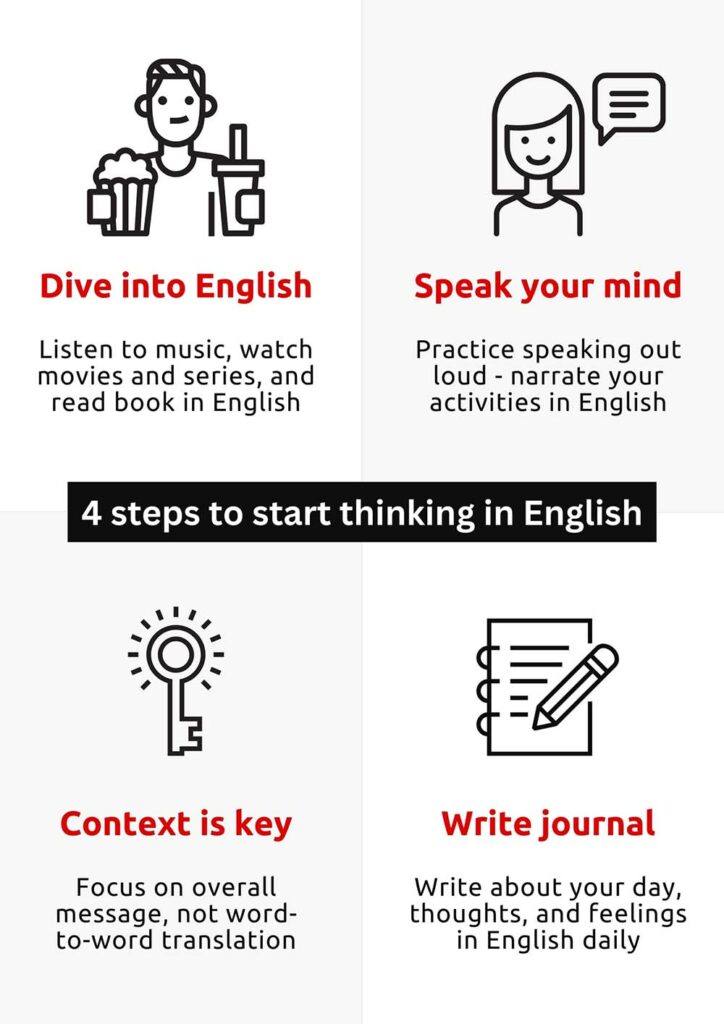
How to start thinking in English: 7 essential tips
Ever caught yourself in the middle of a conversation, mentally flipping through an invisible dictionary in your head, trying to translate your thoughts into English?
Well, here’s the kicker: the secret to fluency isn’t just about mastering grammar or expanding your vocabulary (though those are certainly part of the equation). It’s about making the leap from translating to thinking directly in English. Easier said than done, right?
But fear not! I’ve been down this road, and I’ve got some tried-and-tested tips up my sleeve that transformed the way I interact with English. And guess what? I’m ready to spill the beans so you can skip the translator and start thinking in English like it’s your second nature!
So, without further ado, let’s get started!

1. Surround yourself with English
Imagine turning your life into an English-only zone. Sounds a bit like jumping into the deep end, doesn’t it?
But here’s the thing – it’s one of the most effective ways to train your brain to start thinking in English. It’s about creating an immersive environment where English becomes as familiar to you as the melody of your favorite song!
First up, movies and TV shows. But here’s a twist – turn on the subtitles. Not just any subtitles, but English subtitles. It’s like having a language coach right there on the screen, guiding you through every line and helping you connect the spoken and written word. It’s a double whammy of learning!
Now, let’s talk tunes. Music has this magical ability to stick in your head long after the song has ended. So, why not make those sticky tunes English ones? Sing along to the lyrics (shower concerts are highly encouraged), and you’ll find yourself picking up phrases and expressions without even trying. Before you know it, you’ll be thinking in lyrics and idioms, English style!
And of course, books! The gateways to new worlds. Whether you’re into heart-thumping thrillers, soul-stirring romances, or mind-bending sci-fi, reading in English opens up a universe of words and expressions. It’s not just about following a story; it’s about seeing the language in action, understanding its rhythms, and getting cozy with its nuances.
The trick is to weave English so seamlessly into your daily fabric that it stops being ‘something you’re learning’ and becomes ‘something you’re living’. Watch your favorite English YouTube channels while you cook, listen to English podcasts as you jog, and swap your news source to an English-speaking outlet. Make English unavoidable, inescapable, and utterly enjoyable.
By making English an integral part of your environment, your brain will start to pick up on it naturally. It’s like osmosis; you’ll absorb the language without the hard grind of traditional studying. So, saturate your surroundings with English and watch as your brain begins to think, dream, and even joke in the language. Welcome to your new English-enriched life!
2. Speak English out loud
Ever caught yourself narrating life in your head, like you’re the main character in a movie? Well, it’s time to turn that inner monologue into an outer dialogue, in English, of course!
Start by making your daily routine an open diary in English. From the moment you wake up, narrate your life as if you’re the protagonist of an English-speaking vlog. “And here we have the daunting task of leaving the warm embrace of the bed,” you might say, adding a dramatic flair to the mundane!
This simple habit does wonders. It’s not just about getting better at remembering English words; it’s about building your courage to use them. The more you chat, even if it’s just with your coffee cup, the more comfortable English feels. Before you know it, you’ll be eager to join in conversations!
And here’s something cool: when you talk out loud, you have to think fast. This is great practice for real conversations, where you don’t have time to stop and translate everything in your head.
Plus, the more you do it, the smoother your English gets. You’ll find words faster and put your thoughts into sentences more easily. It’s like your mouth and brain start working better together.
So, start talking to yourself, your surroundings, or even your pet in English. It might feel strange at first, but it’s a fun way to get better at thinking and speaking in English without needing to translate everything in your head!
3. Use images
Our brains love visuals. We’re hardwired to remember and understand things better when we see them. That’s why linking English words to images can be a game-changer in your learning journey!
By pairing new English words directly with images, you’re teaching your brain to bypass the translation step. It’s like creating a shortcut from the word to its meaning. This not only speeds up how quickly you pick up new vocabulary but also helps you think in English more naturally.
Pictures do more than just represent a word; they provide a rich context that can bring complex ideas or unfamiliar vocabulary into clearer focus. An image can convey nuances and meanings that words alone might not fully capture, especially for abstract concepts that can be tricky to grasp.
Getting hands-on with your learning by choosing images, associating them with new words, and using them in various exercises makes your study sessions more dynamic. This active involvement with the language, as opposed to just passively reading or listening, encourages deeper learning and longer-lasting memory.
So, dive into the world of visual learning. Create flashcards, use apps, or draw your own pictures. Surround yourself with these visual cues, and watch as your English vocabulary blossoms!
4. Live your day in English
Imagine your day as an English narrative. Whether you’re cooking breakfast or taking a walk, turn these moments into live English practice sessions!
While chopping vegetables, think, “Now, I’m cutting the carrots into small pieces.” It’s straightforward, but it’s effective. These simple English sentences during regular activities train your brain to process and respond in English naturally.
This method does more than just improve your English skills; it embeds the language into your daily life. By thinking in English about the tasks at hand, you’re not only practicing the language but also making it a vital part of your everyday thinking process.
So, next time you’re doing something routine, switch your brain to English mode. Describe what you’re doing, what you plan to do next, and even how you feel about it, all in English. This continuous practice helps bridge the gap between learning English and living it, making the transition to thinking in English smoother and more instinctive!
5. Step away from translation apps
Relying heavily on translation apps is like always using a GPS in your hometown; it prevents you from truly learning the lay of the land!
While these apps can be handy in a pinch, leaning on them too much can keep you from developing the ability to think and express yourself in English naturally.
Challenge yourself to step outside the comfort zone of instant translation. When you encounter a hurdle, rather than immediately turning to an app, try to navigate around it using the English words and phrases you already know. This might mean explaining a concept with more basic terms or using synonyms and descriptions to get your point across.
This practice not only enriches your vocabulary and enhances your communicative skills but also strengthens your mental flexibility in using English. It pushes you to actively engage with the language, piecing together what you know to form new expressions and understandings!
6. Use context clues
When you stumble upon words or phrases in English that seem unfamiliar, think of them as pieces of a larger puzzle. Before rushing to translate these pieces, take a step back and assess the picture they’re part of—the context! The sentences surrounding the word, the overall topic of conversation, and even the speaker’s tone can provide invaluable clues to deciphering meaning.
This method is great because it helps you understand English in full sentences and stories, not just word by word. It teaches you to see the big picture, which is how we really use language!
As you get better at finding clues in the context, you’ll feel more sure of yourself with English. This boost in confidence will make you want to use English more in your day-to-day life, helping you make the big leap to thinking in English!
Learning through context also lets you in on the cultural bits and sayings that don’t translate well. Getting these parts of the language can make you more in tune with the culture behind the language, making your whole language learning journey richer.
7. Keep a journal
What if the key to unlocking English fluency lay in recounting your daily experiences?
Writing consistently in English immerses you in active language construction. You’re not just passively absorbing information; you’re creating it!
This process of forming sentences, selecting the right words, and applying grammar rules solidifies your language skills and fosters English thought patterns.
The personal nature of a journal makes it a unique tool. When you tie English to your life’s stories, victories, and challenges, the language becomes a part of you. It shifts from something external to a medium that captures the essence of your experiences, making thinking in English more instinctive.
Moreover, the routine of writing regularly in English establishes a rhythm of anticipation and preparation. As you look forward to your journaling sessions, your mind begins to organize thoughts in English, readying them for the page!
Your journal offers a judgment-free zone to experiment with English. Here, you can play with new expressions, tackle complex sentence structures, and test out idiomatic phrases without fear. This freedom not only enhances your linguistic fluency but also builds the confidence necessary for thinking in English.
In essence, journaling is a bridge between learning English and living it. By narrating your life’s story through the lens of a new language, you’re not just documenting your days; you’re crafting a mindset that embraces English at its core, making the leap to thinking in the language not just a goal, but a reality!
At IELC, we teach English the right way
Our goal is to get you speaking in English with fluency and confidence as fast as possible. We want to give you the skills you need to fulfil your potential!
Our experienced teachers will guide you along every step of the learning process to ensure that you are not wasting your time, money, and energy on useless language exercises & wrong methods.
Our courses
With our modern campus and technology, we are equipped to provide the best possible courses for children, teens, and adults, including:
Online and on campus IELTS courses
Online and on campus TOEFL PBT courses
Online and on campus TOEFL iBT courses
We offer our classes in group classes or private classes.
No matter what your goals are, our team will help you achieve these goals by providing you with Indonesia’s best English courses!
Talk to our team today to get your FREE consultation and take your first step towards success.
Sincerely,

IELC Academic Director
